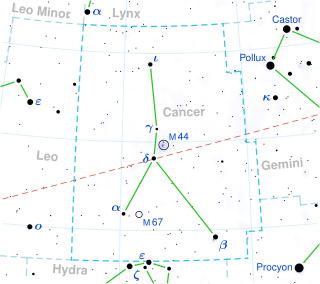astro.wikisort.org - Star
G 9-38, also known as EI Cancri and GJ 1116, is a binary star system consisting of two M-type stars.[11] At 16.7 light-years from the Sun, the system is relatively nearby.[12] The system has a very high stellar flare activity, with average five flares per hour.[1]
 An ultraviolet band light curve showing several flares on EI Cancri, adapted from Pettersen (1985)[1] | |
| Observation data Epoch J2000 Equinox J2000 | |
|---|---|
| Constellation | Cancer |
| Right ascension | 08h 58m 15.194s[2] |
| Declination | +19° 45′ 47.08″[2] |
| Apparent magnitude (V) | 13.720[3] |
| Characteristics | |
| Spectral type | M8Ve+M7V[4][5] |
| Astrometry | |
| G 9-38 A | |
| Radial velocity (Rv) | 13 ± 5[6] km/s |
| Proper motion (μ) | RA: −767.060±0.122[7] mas/yr Dec.: −100.176±0.083[7] mas/yr |
| Parallax (π) | 194.1443 ± 0.1228 mas[7] |
| Distance | 16.80 ± 0.01 ly (5.151 ± 0.003 pc) |
| G 9-38 B | |
| Proper motion (μ) | RA: −937.133±0.190[8] mas/yr Dec.: −34.559±0.138[8] mas/yr |
| Parallax (π) | 196.2619 ± 0.1976 mas[8] |
| Distance | 16.62 ± 0.02 ly (5.095 ± 0.005 pc) |
| Orbit | |
| Primary | G 9-38A |
| Companion | G 9-38B |
| Period (P) | 360 yr |
| Semi-major axis (a) | 33 AU |
| Details[9][10] | |
| G 9-38A | |
| Mass | 0.12 M☉ |
| Luminosity (bolometric) | 0.000965 L☉ |
| Temperature | 2896±18 K |
| Metallicity [Fe/H] | -0.12(unreliable) dex |
| G 9-38B | |
| Mass | 0.10 M☉ |
| Luminosity (bolometric) | 0.000992 L☉ |
| Other designations | |
| A: Gaia DR2 660597997696173440, LHS 2076[4], NLTT 20638[4] | |
| B: Gaia DR2 660597997697274752, LHS 2077[5], NLTT 20637[5] | |
| Database references | |
| SIMBAD | The system |
| A | |
| B | |
 G 9-38 Location of G 9-38 in the constellation Cancer | |
In 2015, the search for third star in the system has yielded inconclusive results.[13]
References
- Pettersen, B. R. (July 1985). "Discovery of flare activity on the low luminosity red dwarf system G9-38 AB". Astronomy & Astrophysics. 148: 151–154. Retrieved 11 November 2021.
- Cutri, Roc M.; Skrutskie, Michael F.; Van Dyk, Schuyler D.; Beichman, Charles A.; Carpenter, John M.; Chester, Thomas; Cambresy, Laurent; Evans, Tracey E.; Fowler, John W.; Gizis, John E.; Howard, Elizabeth V.; Huchra, John P.; Jarrett, Thomas H.; Kopan, Eugene L.; Kirkpatrick, J. Davy; Light, Robert M.; Marsh, Kenneth A.; McCallon, Howard L.; Schneider, Stephen E.; Stiening, Rae; Sykes, Matthew J.; Weinberg, Martin D.; Wheaton, William A.; Wheelock, Sherry L.; Zacarias, N. (2003). "VizieR Online Data Catalog: 2MASS All-Sky Catalog of Point Sources (Cutri+ 2003)". CDS/ADC Collection of Electronic Catalogues. 2246: II/246. Bibcode:2003yCat.2246....0C.
- Zacharias, N. (2012). "The fourth US Naval Observatory CCD Astrograph Catalog (UCAC4)". VizieR On-line Data Catalog. Bibcode:2012yCat.1322....0Z.
- "G9-38A". SIMBAD. Centre de données astronomiques de Strasbourg. Retrieved 29 September 2020.
- "G9-38B". SIMBAD. Centre de données astronomiques de Strasbourg. Retrieved 29 September 2020.
- "G9-38". SIMBAD. Centre de données astronomiques de Strasbourg. Retrieved 29 September 2020.
- Brown, A. G. A.; et al. (Gaia collaboration) (2021). "Gaia Early Data Release 3: Summary of the contents and survey properties". Astronomy & Astrophysics. 649: A1. arXiv:2012.01533. Bibcode:2021A&A...649A...1G. doi:10.1051/0004-6361/202039657. S2CID 227254300. (Erratum: doi:10.1051/0004-6361/202039657e). Gaia EDR3 record for this source at VizieR.
- Brown, A. G. A.; et al. (Gaia collaboration) (2021). "Gaia Early Data Release 3: Summary of the contents and survey properties". Astronomy & Astrophysics. 649: A1. arXiv:2012.01533. Bibcode:2021A&A...649A...1G. doi:10.1051/0004-6361/202039657. S2CID 227254300. (Erratum: doi:10.1051/0004-6361/202039657e). Gaia EDR3 record for this source at VizieR.
- Rojas-Ayala, Bárbara; Covey, Kevin R.; Muirhead, Philip S.; Lloyd, James P. (2011), "Metallicity and Temperature Indicators in M dwarf K band Spectra: Testing New & Updated Calibrations With Observations of 133 Solar Neighborhood M dwarfs", The Astrophysical Journal, 748 (2): 93, arXiv:1112.4567, doi:10.1088/0004-637X/748/2/93, S2CID 41902340
- Nearby Star Summary Table
- Vizier query: Name=G* 1116, Centre de Données astronomiques de Strasbourg , accessed 30 December 2012.
- Nearby Stars Catalog (NSC), Planetary Habitability Laboratory, University of Puerto Rico at Arecibo accessed 31 December 2012.
- Davison, Cassy L.; White, R. J.; Henry, T. J.; Riedel, A. R.; Jao, W-C.; Bailey Iii, J. I.; Quinn, S. N.; Cantrell, J. R.; Subasavage, J. P.; Winters, J. G. (2015), "A 3D Search for Companions to 12 Nearby M-Dwarfs", The Astronomical Journal, 149 (3): 106, arXiv:1501.05012, Bibcode:2015AJ....149..106D, doi:10.1088/0004-6256/149/3/106, S2CID 9719725
- Dittmann, Jason A.; Irwin, Jonathan M.; Charbonneau, David; Berta-Thompson, Zachory K. (2014). "Trigonometric Parallaxes for 1507 Nearby Mid-to-late M Dwarfs". The Astrophysical Journal. 784 (2): 156. arXiv:1312.3241. Bibcode:2014ApJ...784..156D. doi:10.1088/0004-637X/784/2/156. S2CID 18789867. Table with parallaxes.
На других языках
- [en] G 9-38
[es] GJ 1116
GJ 1116 (G 9-38) es un sistema estelar en la constelación de Cáncer. A una distancia de 17,0 años luz del sistema solar, es uno de los 100 sistemas más próximos a la Tierra.[1]Текст в блоке "Читать" взят с сайта "Википедия" и доступен по лицензии Creative Commons Attribution-ShareAlike; в отдельных случаях могут действовать дополнительные условия.
Другой контент может иметь иную лицензию. Перед использованием материалов сайта WikiSort.org внимательно изучите правила лицензирования конкретных элементов наполнения сайта.
Другой контент может иметь иную лицензию. Перед использованием материалов сайта WikiSort.org внимательно изучите правила лицензирования конкретных элементов наполнения сайта.
2019-2025
WikiSort.org - проект по пересортировке и дополнению контента Википедии
WikiSort.org - проект по пересортировке и дополнению контента Википедии